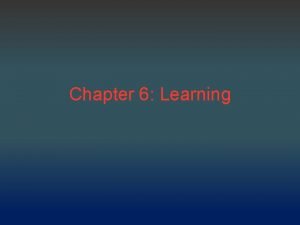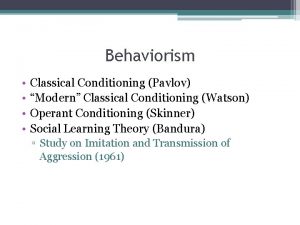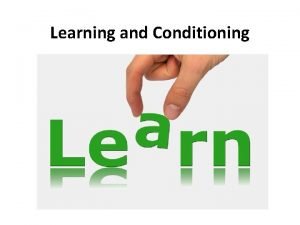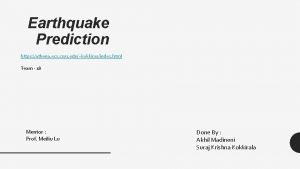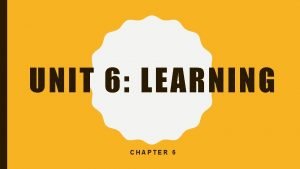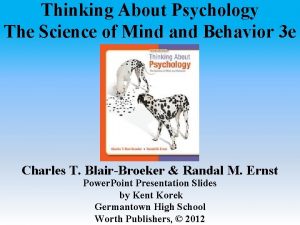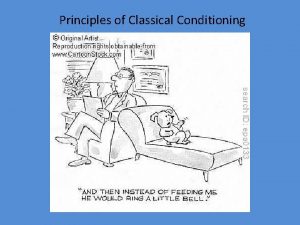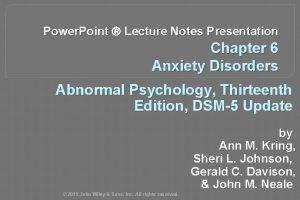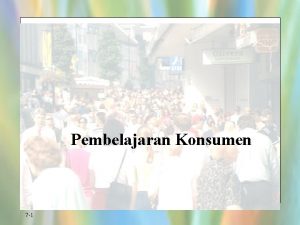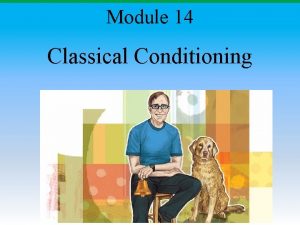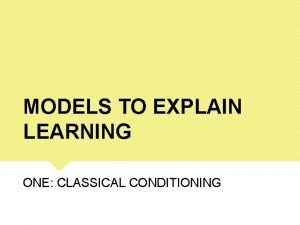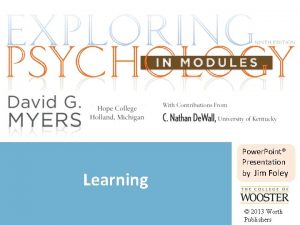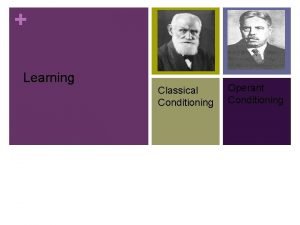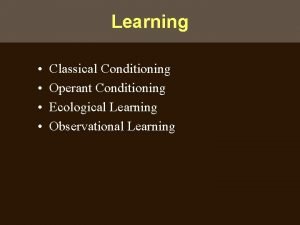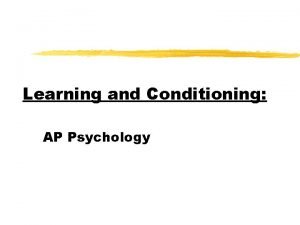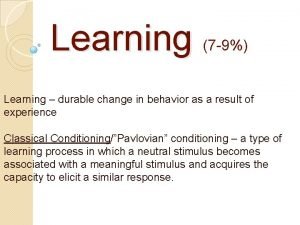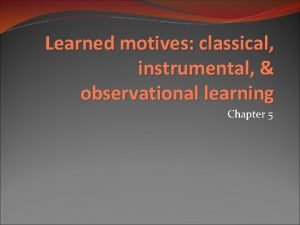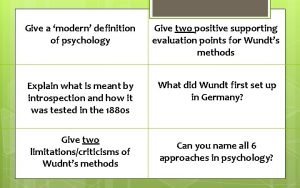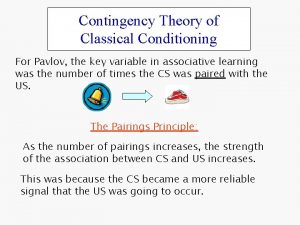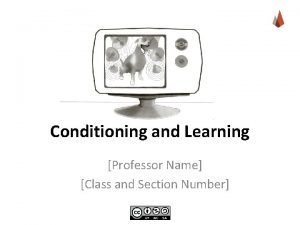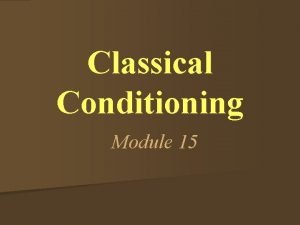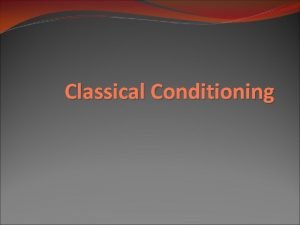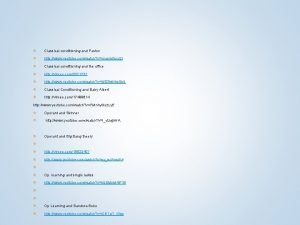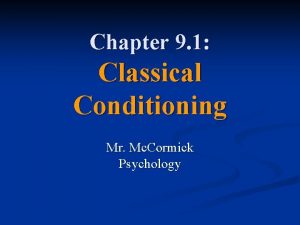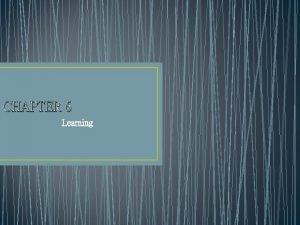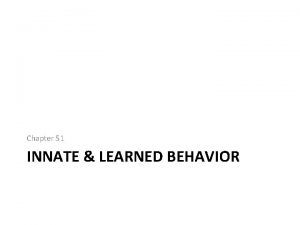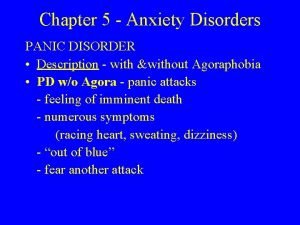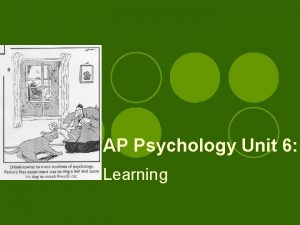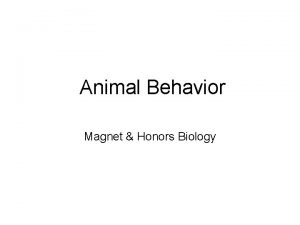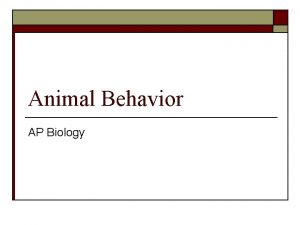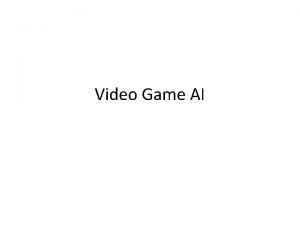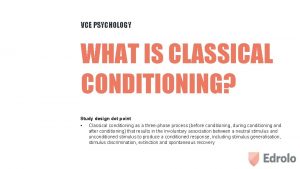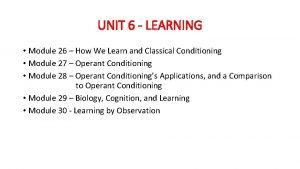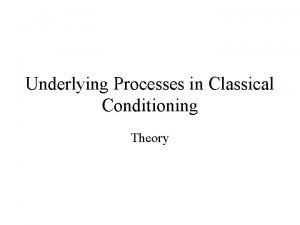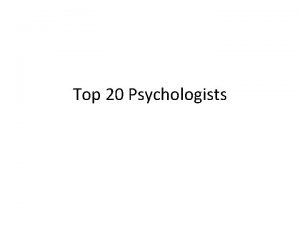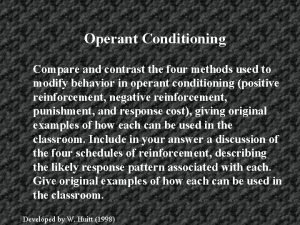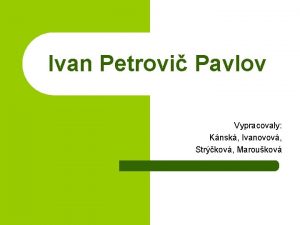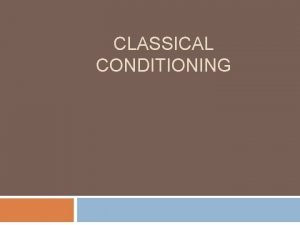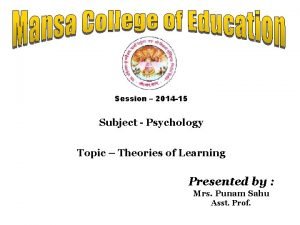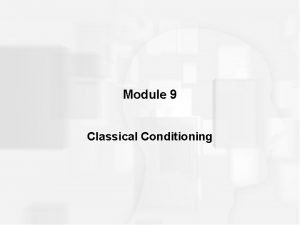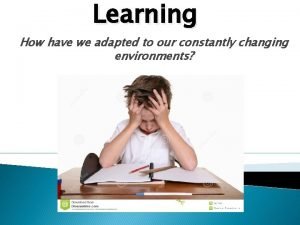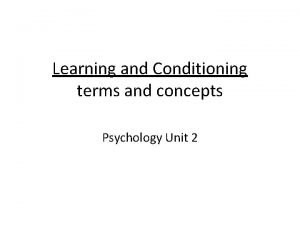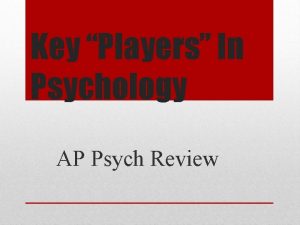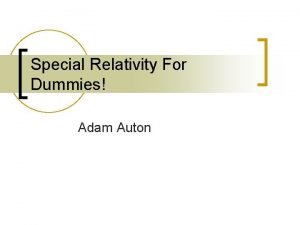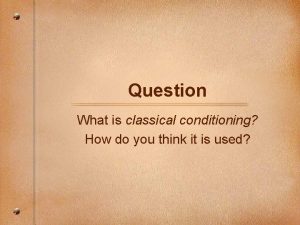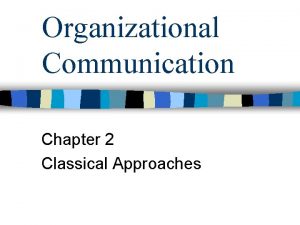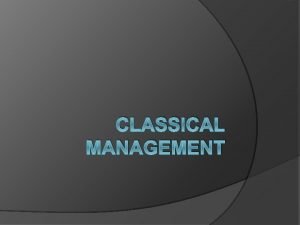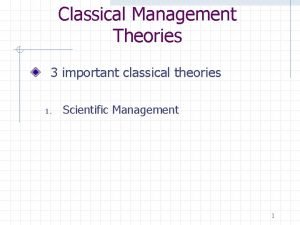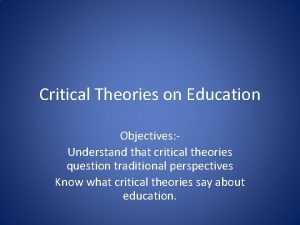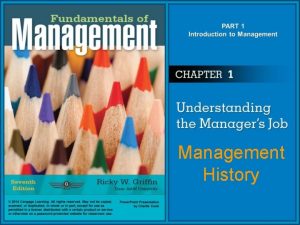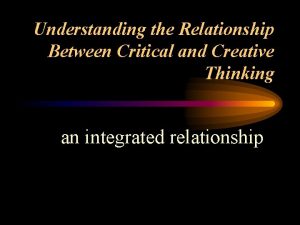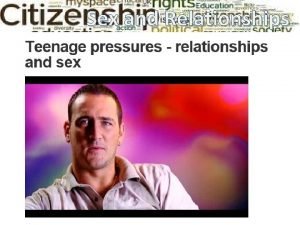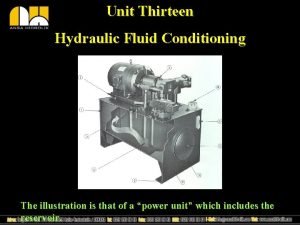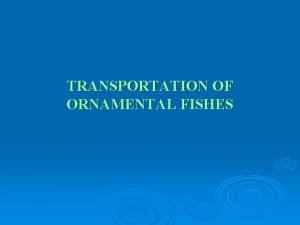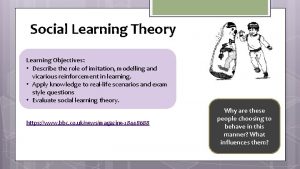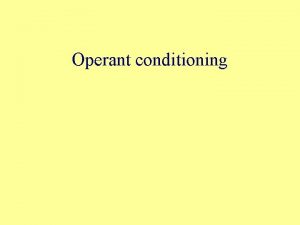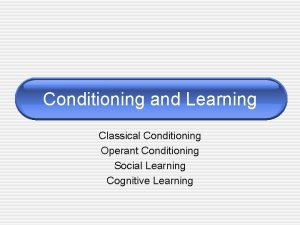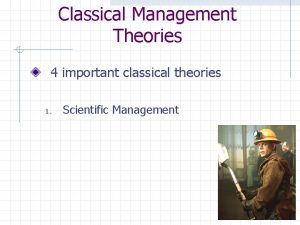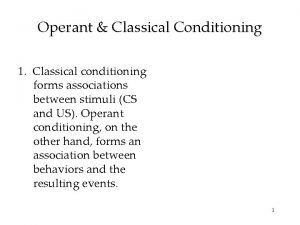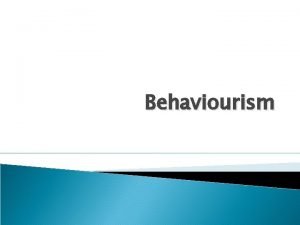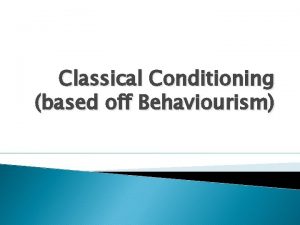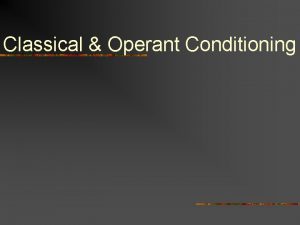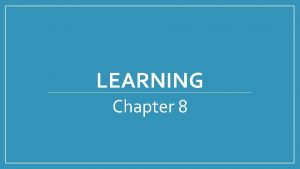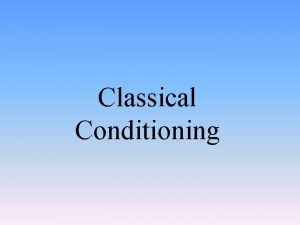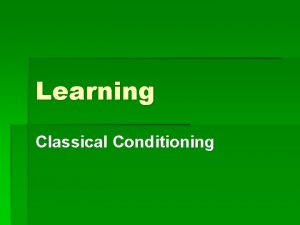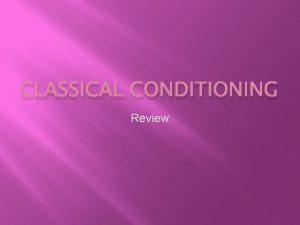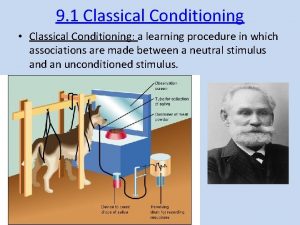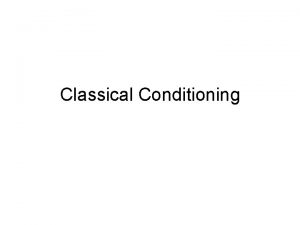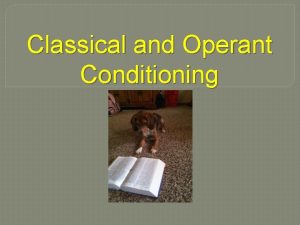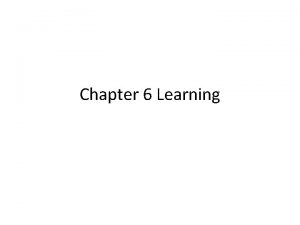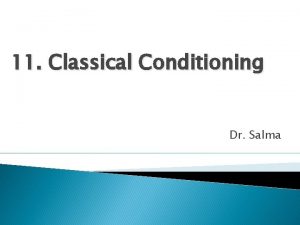Theories of Classical Conditioning Critical CSUS relationship Important











































































- Slides: 75

Theories of Classical Conditioning

Critical CS-US relationship • Important (critical) things to note about classical conditioning: – the CS MUST precede the US – the CS MUST predict the US – if the CS does not predict the US, no conditioning occurs – the CR does not have to be identical to the UR • E. g. , subtle differences even Pavlov noticed) • may even be opposite: Morphine studies • Any response is a classically conditioned response if it – occurs to a CS – after that CS has been paired with a US – but does NOT occur to a randomly presented CS-US pairing

Theories of Classical Conditioning: WHY do organisms respond to predictability? • Pavlov: Stimulus substitutability theory • Kamin: Surprise theory • Rescorla and Wagner: Computational Model • Current Attentional Models

Pavlov: Stimulus Substitution Theory – Basic premise of theory: CS substitutes for US • w/repeated pairings between CS and US, CS becomes substitute for the US • thus, the response initially elicited only by US is now also elicited by CS – sounds pretty good: • salivary conditioning: US and CS both elicit salivation • eyeblink conditioning: both elicit eyeblinks – Theory was doing well until we found compensatory CRs

Pavlov: Stimulus Substitution Theory – Criticisms and Flaws: • CR is almost never an exact replica of the UR • An eyeblink to UR of air puff = large, rapid closure • Eyeblink to CS of tone = smaller, more gradual closure • Defense of theory: Hilgard (1936): Why differences in CR and UR: – Intensity and stimulus modality of the CS and US are different – Thus: differences in Response magnitude and timing are to be expected – But still doesn’t explain OPPOSITE CR

Pavlov: Stimulus Substitution Theory • BIGGER PROBLEM: – Whereas many US's elicit several different R's, as a general rule not all of these R's are later elicited by the CS – CS seems to select for certain CRs • E. g. Zener (1937) – Dog presented w/food as US: • found that the dog elicited a number of UR responses to the food • E. g. , salivation, chewing, swallowing, etc. – CS not elicit all of those responses • NO CRs of chewing and swallowing • Just the CR of just salivation • On other hand: CR may contain some of responses that are not part of CR: – Zener found that dogs turned head to bell – But no head turns to presentation of food

Modifications of SST • MODIFICATIONS OF SST: (Hilgard) – Only some components of UR transferred to CR – CS such as a bell often elicits unconditioned responses of its own, and these may become part of CR • Remember SIGN TRACKING: Brown and Jenkins 1974 – Emphasized this change in form of CR vs. UR – Also Jenkins, Barrara, Ireland Woodside (1976) • Sign Tracking : animals tend to – Orient themselves toward the CS (not the US) – Approach – Explore any stimuli that are good predictors of important events such as the delivery of food

1 4 2 Set up: 1. Initial training: Light turns on above feeder releases pieces of hot dog 2. Test: a. Light turns on above feeder, then above each of the other walls b. Forms a sequence of 1 2 3 4 3. What is optimal response? 3 Jenkins, Barrara, Ireland Woodside (1976) 4. But: Dog “tracked the sign”

Modifications of SST • Strongest data against SST theory: Paradoxical conditioning – CR in opposite direction of UR • Black (1965): – heart rate decreases to CS paired w/shock – US of shock elicits UR of heart rate INCREASE – But CS of light or tone elicits CR of heart rate DECREASE • Seigel (1979): conditioned compensatory responses – – Morphine studies evidence of down regulation in addiction Actual cellular process in neurons (and other cells, too!) thus SST theory appears incorrect

Perceptual Gating Theory • Perceptual gating theory: – Idea that only if CS is biologically relevant will it get processed – If a CS doesn’t get processed it can be predictive/informative – Animals attend to biologically relevant stimuli • Problem: – Data show that under certain circumstances a stimulus is “attended to” or “processed”, but still does not serve as a CS with an accompanying CR – Issue remains: is the stimulus the most predictive? – Second issue: Defining “biologically relevant”

Kamin’s work: 1967 -1974 Blocking and overshadowing • Overshadowing: – – use one "weak" and one "strong" CS CS 1+CS 2 US reaction to weaker stimulus is blotted out by stronger CS Demonstrated by Pavlov • Blocking: – Train 1 CS, then add a second CS to it: • CS 1 US • CS 1+CS 2 US – test each individually after training – Find that only one supports a CR – One stimulus “blocks” learning to second CS – Demonstrated by Kamin

Kamin’s blocking experiment • Used multiple CS's and 4 groups of rats • The blocking group receives – series of L+ trials which produce strong CR – series of L+T+ trials – then tested to just the T • The Control groups receives – SAME TOTAL NUMBER OF TRIALS AS BLOCKING GROUP – no first phase – L+ only; Test T – T+ only; Test T – LT+ only: Test T

Kamin’s blocking experiment • Prediction: since both received same # of trials to the tone- should get equal conditioning to the tone • Results quite different: Blocking group shows no CR to the tonethe prior conditioning to the light "blocked" any more conditioning to the tone • Directly contradicts frequency principle (remember associationism!) Group Control Blocking Phase I ------L+ Phase II L+ T+ LT+ Test Phase Result T T elicits no CR T T elicits a CR T T elicits no CR

Things we know about blocking: • The animal does "detect" the stimulus: – can’t be perceptual gating issue – EXT of CR with either T alone or with LT – EXT occurred faster with compound LT • Appears to be independent of: – length of presentation of the CS – number of trials of conditioning to compound CS • Constancy of US from phase 1 to 2 important!!!! – US must remain identical between the two phases or no blocking • Influenced by: – Type of CR measure (used CER, not as stable as non fear CR) – nature of CS may be important- e. g. modality – intensity of CS or US stimuli important • Depends on amount of conditioning to blocking stimulus which already occurred

Change in either US or CS can prevent/ overcome blocking • Change the intensity of the CS from phase 1 to phase 2 – – – Overshadowing could be playing a role strong vs weak stimulus e. g. experiments when changed from 1 ma to 4 ma shock quickly condition to compound stimulus little or no overshadowing or blocking • Change in intensity of either CS stimulus– Change in context from Phase 1 to Phase 2 • l. T • Lt then T – presents a different learning situation and no blocking • Any ideas about what is happening?

Explanations of Blocking: • Poor Explanation: Perceptual gating theory: – tone never gets processed – tone not informative – data not really support this (evidence that do “hear” tone) • Good Explanation: Kamin's Surprise theory: – to condition requires some mental work on part of animal – animal only does mental work when surprised – bio genetic advantage: prevents having to carry around excess mental baggage – thus only learn with "surprise" – situation must be different from original learning situation • Better Explanation: Rescorla Wagner model: – particular US only supports a certain amount of conditioning – if one CS “hogs” all that conditioning- none is left over for another CS to be added – question- how do we show this?

A Brief Aside • Must determine how CS-US relationship works • Rescorla (1966) spent a lot of time on control groups – What exactly IS a control group in classical conditioning? – Why is this important? – Question of contiguity vs. predictability at play here.

Recorla: Which is more important? CS-US correlation vs. contiguity • CS-US contiguity: – CS and US are next to one another in time/space – In most cases, CS and US are continguous • CS-US correlation: CS followed by the US in a predictive correlation: • If perfect correlation (most predictive)- most conditioning • p(US/CS) = 1. 0 • p(US/no CS) = 0. 0 • But: life not always a perfect correlation

CS-US correlation is more critical • Rescorla (1966, 1968): Showed how 2 probabilities interact to determine size of the CS – CS = 2 min tone; presented at random intervals (M = 8 min) – Group 1: p(shock/CS) = 0. 4 during 2 min presentation – Group 2: p(shock/no CS) = 0. 2 • Which group should show more conditioning? • WHY?

Robert Rescorla (1966) Examined predictability 6 types of Groups • CS-alone – present CS alone with no US pairing – problem: not have same number of US trials as experimental animals do, may actually be extinction effect • Novel CS group: – looks at whether stimulus is truly "neutral" – may produce habituation- animal doesn't respond because it "gets used to it" • US-alone – present US alone with no CS pairing – problem: not have same number of CS trials

Rescorla: 6 types of control groups • Explicitly unpaired control – CS NEVER predicts US – that is- presence of CS is really CS-, predicts NO US – animal learns new rule: if CS, then no US • Backward conditioning: – US precedes CS – assumes temporal order is important (but not able to explain why) – again, animal learns that CS predicts no US • Discrimination conditioning (CS+ vs CS-) – use one CS as a plus; one CS as a minus – same problem as explicitly unpaired and backwardworks, but can work in certain circumstances (taste avoidance)

Rescorla: Results with 6 Groups • CS-alone: No conditioning, but habituation to CS • Novel CS group: novel worked better than CS with previous experience. • US-alone: habituation to CS • Explicitly unpaired control: – Got GREAT conditioning – Learned that the CS NEVER predicts the US! • Backward conditioning: – US preceded CS – assumed temporal order is important – It was: Animal learned that CS predicts NO US, but US predicted CS • Discrimination conditioning (CS+ vs CS-) – use one CS as a plus; one CS as a minus – Got discrimination – Animals paid attention to whatever stimulus was MOST PREDICTIVE!

CS-US correlation: Summary of Results • Whenever p(US|CS) > p(US|NO cs): – CS = EXCITATORY CS – that is, CS predicts US – Amount of learning depended on size difference between p(US/CS) and p(US/no CS) • Whenever p(US|CS) <p(US|NO CS): – CS = INHIBITORY CS – CS predicts ABSENCE of US – Amount of learning depended on size difference between p(US/CS) and p(US/no CS) • Whenever p(US|CS) = p(US|NO CS): – CS = NEUTRAL CS – CS doesn’t predict or not predict CS – No learning will occur because there is no predictability.

CS-US correlation vs. contiguity • Thus: appears to be the CORRELATION between the CS and US, not the contiguity (closeness in time) that is important • Can write this more succinctly: – correlation carries more information than contiguity – if r = + then excitatory CS – if r = - then inhibitory CS – if r = 0 then neutral CS (not really even a CS)

Classical condition is “cognitive” (oh the horror of that statement, I am in pain) • PREDICTABILITY is critical • Learning occurs slowly, trial by trial – Each time the CS predicts the US, the strength of the correlation is increased – The resulting learning curve is monotonically increasing: • Initial steep curve • Levels off as reaches asymptote – There is an asymptote to conditioning to the CS: • Maximum amount of learning that can occur • Maximum amount of responding that can occur to CS in anticipation of the upcoming US • We can explain this through an equation!

The Rescorla Wagner Equation!: • Yields an equation: THE Rescorla Wagner (1974) model!!!!! Vi =αißj(Λj-Vsum) – Vi = amount learned (conditioned) on a given trial – Αi = the salience of the CS – ßj = the salience of the US – (Λj-Vsum) = total amount of conditioning that can occur to a particular CS-US pairing

The Rescorla Wagner Equation!: • Yields an equation: THE Rescorla Wagner (1974) model!!!!! Vi =αißj(Λj-Vsum) • What does this equation say? • The amount of conditioning that will occur on a given trial is a function of: • The size of the salience of the CS multiplied by • The size of the salience of the US multiplied by • (The maximum amount of learning) - (the amount of learning that has already occurred).

Can say this easier! • How much you will learn on a given trial (Vi) is a function of: – αi or how good a stimulus the CS is (how well it grabs your attention) – ßj or how good a stimulus the US is (how well it grabs your attention – Λj or how much can learning can be learned about the CS-US relationship – AND Vsum or how much you have learned ALREADY!

Assumptions of Rescorla-Wagner (1974) model • Model developed to accurately predict and map learning as it occurs trial by trial • Assumes a bunch of givens: – Assume animal can perceive CS and US, and can exhibit UR and CR – Helpful for the animal to know 2 things about conditioning: • what TYPE of event is coming • the SIZE of the upcoming event • Thus, classical conditioning is really learning about: – signals (CS's) which are PREDICTORS for – important events (US's)

Assumptions of R-W model • Assumes that with each CS-US pairing 1 of 3 things can happen: – The CS might become more INHIBITORY – The CS might become more EXCITATORY – There is no change in the CS • How do these 3 rules work? – If US is larger than expected: CS = excitatory – If US is smaller than expected: CS= inhibitory – If US = expectations: No change in CS • The effect of reinforcers or nonreinforcers on the change of associative strength depends upon: – The existing associative strength of THAT CS – AND on the associative strength of other stimuli concurrently present

More assumptions • Explanation of how an animal anticipates what type of CS is coming: – Direct link is assumed between "CS center" and "US center": • E. g. between a tone center and food center • In 1970’s: other researchers thought R and W were crazy with this idea • Now: neuroscience shows formation of neural circuits! – Assumes that STRENGTH of an event is given • The conditioning situation is predicted by the strength of the learned connection – THUS: when learning is complete: • The strength of the association relates directly to the size or intensity of the CS • Asymptote of learning = max learning that can occur to that size or intensity of a CS • Maximum amount of learning that a given CS can support

More assumptions • The change in associative strength of a CS as the result of any given trial can be predicted from the composite strength resulting from all stimuli presented on that trial: – Composite strength = summation of conditioning that occurs to all stimuli present during a conditioning trial – If composite strength is LOW: • the ability of reinforcer to produce increments in the strength of component stimuli is HIGH • More can be learned for this trial – If the composite strength is HIGH: • reinforcement is relatively less effective (LOW) • Less can be learned for this trial- approaching max of learning

More assumptions: • Can expand to extinction, or nonreinforced trials: – if composite associative strength of a stimulus compound is high, then the degree to which a nonreinforced presentation will produce a decrease in associative strength of the components is LARGE – if composite associative strength is lownonreinforcement effects reduced

WHY is this equation important? • We can use three rules to make predictions about amount and direction of classical conditioning • λ j > Vsum = excitatory conditioning – The degree to which the CS predicted the size of the US was GREATER than expected, so you react MORE to the CS next trial • λ j < Vsum = inhibitory conditioning – The degree to which the CS predicted the size of the US was LESS than expected, so you react LESS to the CS next trial • λ j = Vsum = no change: – The CS predicted the size of the US exactly as you expected

The Equation: Let’s USE it to Explain Learning, Overshadowing and Blocking!: Vi =αißj(Λj-Vsum) • Vi = amount learned (conditioned) on a given trial • Αi = the salience of the CS • ßj = the salience of the US • (Λj-Vsum) = total amount of conditioning that can occur to a particular CS-US pairing

Okay, you got all that? Let’s put this baby to work……. we will try a few examples

The equation: Vi =αißj(λ j-Vsum) • Vi = change in associative strength that occurs for any CS, i, on a single trial • αi = stimulus salience (assumes that different stimuli may acquire associative strength at different rates, despite equal reinforcement) • ßj = learning rate parameters associated with the US (assumes that different beta values may depend upon the particular US employed) • Vsum = associative strength of the sum of the CS's (strength of CS-US pairing) • λ j= associative strength that some CS, i, can support at asymptote • In English: How much you learn on a given trial is a function of the value of the stimulus x value of the reinforcer x (the absolute amount you can learn minus the amount you have already learned).

Acquisition • first conditioning trial: Assume (our givens) – CS = light; US= 1 ma Shock – Vsum = Vl; no trials so Vl = 0 – thus: λ j-Vsum = 100 -0 = 100 – -first trial must be EXCITATORY • BUT: must consider the salience of the light: – αi = 1. 0 – ßj = 0. 5

Acquisition • first conditioning trial: CS = light; US= 1 ma Shock – Vsum = Vl; no trials so Vl = 0 – thus: λ j-Vsum = 100 -0 = 100 – -first trial must be EXCITATORY • BUT: must consider the salience of the light: αi = 1. 0 and learning rate: ßj = 0. 5 • Plug into the equation: for TRIAL 1 – VL = (1. 0)(0. )(100 -0) = 0. 5(100) = 50 – thus: V only equals 50% of the discrepancy between Aj an Vsum for the first trial

Acquisition • Plug into the equation: – for TRIAL 1 –VL = (1. 0)(0. )(100 -0) = 0. 5(100) = 50 –thus: VL only approaches 50% of the discrepancy between Aj and Vsum is learned for the first trial

Acquisition • TRIAL 2: – Same assumptions! – VL = (1. 0)(0. 5)(100 -50) = 0. 5(50) = 25 – Vsum = (50+25) = 75

Acquisition • TRIAL 3: – VL = (1. 0)(0. 5)(100 -75) = 0. 5(25) = 12. 5 – Vsum = (50+25+12. 5) = 87. 5

Acquisition • TRIAL 4: – VL = (1. 0)(0. 5)(100 -87. 5) = 0. 5(12. 5) = 6. 25 – Vsum = (50+25+12. 5+6. 25) = 93. 75 • TRIAL 10: Vsum = 99. 81, etc. , until reach ~100 on approx. trial 14 • When will you reach asymptote?


Now: Back to Explaining Blocking and Overshadowing • Overshadowing: – use one "weak" and one "strong" CS – reaction to weaker stimulus: less CR – Reaction to stronger stimulus: more CR • Blocking: 1 st CS blocks learning to 2 nd CS – At issue: What is predicting what? – Does LT give any more information/predictability than L alone? – If not, then L “blocks” learning to LT

How to explain overshadowing? Yep, it is good old Rescorla-Wagner to the rescue!

Remember Overshadowing • Pavlov: compound CS with 1 intense CS, 1 weak – after a number of trials found: strong CS elicits strong CR – Weak CS elicits weak or no CR • Note: BOTH CSs are presented at same time – Why would one over shadow or overpower the other? – Why did animal not attend equally to both?

Overshadowing • Rescorla-Wagner model helps to explain why: • Assume – αL = light = 0. 2; αT = tone = 0. 5 – ßL = light = 1. 0 ; ßt = tone = 1. 0 • Plug into equation: – Vsum = Vl + Vt = 0 on trial 1 – VL = 0. 2(1)(100 -0) = 20 – Vt = 0. 5(1)(100 -0) = 50 – after trial 1: Vsum = 70

Overshadowing • TRIAL 2: – VL = 0. 2(1)(100 -(50+20)) = 6 – Vt = 0. 5(1)(100 -(50+20)) = 15 – Vsum = (70+(6+15)) = 91 • TRIAL 3: – – VL = 0. 2(1)(100 -(91)) = 1. 8 Vt = 0. 5(1)(100 -(91)) = 4. 5 Vsum = (91+(1. 8+4. 5)) = 97. 3 and so on thus: reaches asymptote (by trial 6) MUCH faster w/2 CS's • NOTE: CSt takes up over 70 units of assoc. strength CSl takes up only 30 units of assoc. strength

Overshadowing

Blocking • Similar explanation to overshadowing: – Does not matter whether VL has more or less saliency than Vt, – CS has basically absorbed all the associative strength that the CS can support • Why?

Blocking • give trials of A-alone to asymptote: – reach asymptote: VL = λ j =100 =Vsum • NOW add trials to compound stimuli: – CS of the light has salience: αL =. 5465 – CS of tone has salience of: ßt =0. 464 – Note that CStone has higher salience! – Eh, oh, the math is going to be TOO HARD to do!!!!!

Blocking • Or IS the math to hard to do? • First compound V 1 Trial: • Vt= αß(Λj-Vsum) • What is Vsum after the training to the CS light? • That’s right Vsum = ______ • Vt=0. *1. 0*(100 -100)= _______ • No learning!

How could one eliminate blocking effect? • increase the intensity of the US to 2 m. A with λ j now equals = 160 – Learning so far: Vsum still equals 100 (learned to 1 m. A shock) – But now: TOTAL learning is increased to 160!

How could one eliminate blocking effect? • plug into the equation: • (assume Vl and Vt equally salient) – Vt = 0. 2(1)(160 -100) = 0. 2(60) = 12 – Vl = 0. 2(1)(160 -100) = 0. 2(60) = 12 – Vsum = 100+12+12 =124

How could one eliminate blocking effect? • on trial 2: – Vsum = 124 – Vt = 0. 2(1)(160 -124) = 0. 2(36) = 7. 2 – Vl = 0. 2(1)(160 -124) = 0. 2(36) = 7. 2 – Vsum now = (124+14. 4) = 138. – Again, monotonically increasing curve. • Thus, altering the salience of the US alters the learning • Does altering the CS make the same change?

Can also explain why probability of reward given CS vs no CS makes a difference: • π = probability of US given the CS or No US given No CS • can make up three rules: – if πax > πa then Vx should be POSITIVE – if πax < πa then Vx should be NEGATIVE – if πax = πa then Vx should be ZERO • modified formula: (assume λ 1 =1. 0; λ 2 =0; ß 1 =. 10; ß 2=. 05; α 1=. 10; α 2=. 5) • Πa = probability of reward.

Explaining loss of Associate Value despite pairings with the US: • Is an unusual prediction: Associative value of a CS can decrease despite continued pairings with the US • Show this with three-phase experiment: – Phase 1: A and B stimuli US (1 food pellet) on separate trials (equal #) – Phase 2: A and B paired together 1 food pellet • Same US, so same amount of conditioning, right? ? • RW model predicts that conditional properties of A and B individually will DECREASE in phase 2. – Why: VA= λ ; VB= λ for phase 1; so VA+B = VA+B=2 λ • This is an over-expectation • Not get 2 pellets, so Phase 2 = decremental conditioning – When test A and B alone: do indeed get decremental responding or Conditioned Inhibition

Conditioned Inhibition • RW model also predicts Conditioned inhibition • Can test for Conditioned inhibition – 2 kinds of trials • CS+ US trials • CS- no US trials – Consider 2 kinds of trials separately • Reinforced trials: CS+ gains excitatory properties • Unreinforced trials: CS- gains inhibitory properties • When presented together: cancel one another out (assuming equal conditioning) • Is a SUMMATIVE effect

Extinction of excitation and inhibition • During extinction: EXT: CS+ no US – Initially: animal expects CS-US and is excitatory – This excitatory expectation is quickly diminished with repeated trials of no US • Decreases the excitatory conditioning incrementally, just like the excitatory conditioning was increased incrementally during learning

Dopamine and Rescorla Wagner Model • Turns out that changes in dopamine (DA) levels in dorsal striatal limbic cortical pathway vary as we learn • And guess what: these levels can be predicted by the RW model! • But, once a CS-US pairing (or an operant R-SR pairing) become well learned, the circuit begins to involve lower parts of the brain – – Circuit begins to involve basal striatal areas Becomes an “automated” or mastered behavior No longer involves being “surprised” Only returns to this pathway if the CS-US relation change!!!!!

Critique of the Rescorla-Wagner Model: • R-W model really a theory about the US effectiveness: – Says little about CS effectiveness – How WELL a CS predicts as a combo of salience and probability but doesn’t really evaluate this – States that an unpredicted US is effective in promoting learning, whereas a well-predicted US is ineffective because nothing is left to learn.

Critique of the Rescorla-Wagner Model: • Fails to predict the CS-pre-exposure effect: – Two groups of subjects • Grp II CS-US pairings CS alone Control CS-US pairings PRE-Expos • Bob and Tom effect – Bob always hangs with Tom – You are dating Tom – You have a BAAAAAD breakup with Tom – Now you hate Bob…. why? • Original model didn’t address how exposure could change salience/learning to CS

Critique of the Rescorla-Wagner Model: • In pre-exposure effect, simply being around a neutral stimulus alters its ability to become conditioned • Original R-W model doesn't predict any difference, – Assumes no conditioning trials occur when CSs presented in absence of US so Vsum = 0 – This appears to be wrong • Conditioning likely occurring any time 2 stimuli are together – Form an incidental association – Need to modify the equation to account for this – They have, but we won’t!

Critique of the Rescorla-Wagner Model: • Original R-W model implies that salience is fixed for any given CS – R-W assume CS salience doesn't change w/experience – More recent data strongly suggest CS salience DOES change w/experience • Why changes in CS salience? – Data suggest that Salience to a CS DECREASES when CS is repeatedly presented without consequence – CS that is accidentally paired with another CS INCREASES in salience – Thus: ppears that CS and US effectiveness are both highly important • Model has stood test of time, now widely used in neuroscience • Given birth to attentional models of CC

Extensions and Alternatives to RW theory • Attentional models • Timing and Information models • Comparator hypothesis

Attentional Models of CC • How well does the CS command attention – Assumes that increased attention facilitates learning about a stimulus – Procedures that disrupt attention to CS disrupt learning • Different attentional models differ in assumptions about what determines how much attention a CS commands on any given trial – Single attentional mechanisms: Kamin’s surprise – Multiple attentional mechanisms:

Multiple attentional mechanisms: • Three attentions: – Looking for action: attention a CS commands after it has become a good predictor of the CS – Looking for learning: how well the organism processes cues that are not yet good predictors of the US, and thus have to be “learned about” – Looking for liking: the emotional/affective properties of the CS • Assume that the outcome of a given trial alters the degree of attention commanded by the CS on future trials – Surprise? Then an increase in looking for learning on next trial – Pleasant outcome? Increases emotional value of CS on next trial

Timing/Information Theory Models • Recognized that time is important factor in CC – Focal search responses become conditioned when CS-US interval is short – General search responses become conditioned when CS-US interval is long – Suggests that organisms learn both • WHAT is predicted • WHEN what is predicted will occur

Temporal coding hypothesis • Organisms learn when the US occurs in relation to the CS • Use this information in blocking, second-order conditioning, etc. • What is learned in one phase of training influences what is learned in subsequent phase • Large literature supports this

Importance of Inter-trial interval • More conditioned responding observed with a longer inter-trial interval – Intertrial interval and CS duration (CS-US interval) act in combination to determine responding – Critical factor: Relative duration of these two temporal intervals rather than absolute value of either one by itself • Holland (2000) – Conditioned rats to an auditory cue that was presented just before delivery to food – CR to CS: nosing of food cup (goal tracking) – Each group conditioned with • 1 of 2 CS durations: 10 or 20 sec • 1 of 6 intertrial intervals: 15 to 960 sec – Characterized responses in terms of theratio of the intertrial interval (I) and the CS duration (T). • Time spent nosing the food cup during CS plotted as function of relative value of I/T – Results: as IT ratio increases, the percentage of time the rats spend with the nose in the food cup increases

Importance of Inter-trial interval • Relative Waiting Time Hypothesis – Organism making comparison between events during the Intertrial interval (I) and Trial interval (T) – How long one has to wait for the US during the CS vs. how long one has to wait for the US during the intertrial interval • When US waiting time during CS is shorter than intertrial interval: – I/T ratio is high – CS is highly informative about the next occurrence of the US – Lots of responding • When US waiting time during CS is same/longer than intertrial interval wait: – I/T ratio is low – CS is not highly informative – Less responding

Comparitor Hypothesis • Ralph Miller, et al. : organism compares across learning situations • Assumes: Conditional responding depends on – What happens during CS – ALSO what happens in other aspects of experimental situation (when CS is not presented) – That is, animal compares presence of CS to absence of CS • Revaluation effects: Can better explain blocking – What is blocked is RESPONDING to CSAB, not learning of CSAB – Can unmask blocking to CSAB by presented CSA alone without US (EXT CSA). • Changes conditional value of CSA • Now CSAB has different, predictive value • Animal “revalues” CSAB and now responds as it is predictive, whereas CSA is not.

Comparator Hypothesis • Note: this is a theory of PERFORMANCE, not learning! – Assumes conditioned responding depends on BOTH associations between CS-US and between US and other stimuli when CS not there – These other stimuli form the “comparator” cues • Also assumes formation of excitatory associations with US ONLY – Instead of forming inhibitory associations with CS, form stronger excitatory associations with “not CS” – Animal compares the relative associative value of “CS vs. “not CS” – Whatever is stronger is what you respond to

Why are these theories important? • Helps explain the PROCESS of classical conditioning • Describes conditions and allows predictions of – – – Who is likely to form associations between stimuli To What kinds of stimuli it will occur When classical conditioning will occur Where associations form: what settings/conditions are important How well: how fast/slow, what quality of associations are formed. • Important for predicting/controlling in applied settings – – Understanding and treatment of pedophilia, sexual fetishes, etc. Phobia treatment Commercials and advertising Social behaviors
 Operant conditioning vs classical conditioning
Operant conditioning vs classical conditioning Albert experiment
Albert experiment Variable interval schedule
Variable interval schedule Instrumental learning vs classical conditioning
Instrumental learning vs classical conditioning Operant vs classical conditioning
Operant vs classical conditioning Fanning oneself to escape from the heat
Fanning oneself to escape from the heat Secondary reinforcers
Secondary reinforcers Classical conditioning vs operant conditioning
Classical conditioning vs operant conditioning Classical conditioning vs operant conditioning
Classical conditioning vs operant conditioning Operant conditioning classical conditioning
Operant conditioning classical conditioning Html
Html Critical semi critical and non critical instruments
Critical semi critical and non critical instruments Spaulding classification system
Spaulding classification system Little albert experience
Little albert experience Pavlovs
Pavlovs Second-order conditioning examples
Second-order conditioning examples Classical conditioning panic disorder
Classical conditioning panic disorder Contoh iklan classical conditioning
Contoh iklan classical conditioning Operant conditioning
Operant conditioning Classical conditioning little albert
Classical conditioning little albert Neutral stimulus
Neutral stimulus Ivan pavlov classical conditioning
Ivan pavlov classical conditioning Conditioned stimulus psychology definition
Conditioned stimulus psychology definition Operant conditioning adalah
Operant conditioning adalah Example of classical conditioning
Example of classical conditioning Insight learning ap psychology
Insight learning ap psychology Classical conditioning generalization
Classical conditioning generalization Can opener
Can opener John watson tabula rasa
John watson tabula rasa Contingency theory of classical conditioning
Contingency theory of classical conditioning Classical conditioning cs us ur cr
Classical conditioning cs us ur cr Real life example of classical conditioning
Real life example of classical conditioning Garcia effect
Garcia effect Youtube classical conditioning
Youtube classical conditioning Mr cormick
Mr cormick Classical conditioning table
Classical conditioning table Fixed action patterns
Fixed action patterns Classical conditioning panic disorder
Classical conditioning panic disorder Unit 6 ap psychology
Unit 6 ap psychology Classical conditioning biology
Classical conditioning biology Types of associative learning
Types of associative learning Generalization classical conditioning
Generalization classical conditioning Classical conditioning game
Classical conditioning game 5 elements of classical conditioning
5 elements of classical conditioning Ap psychology module 26 answers
Ap psychology module 26 answers Preparatory response theory
Preparatory response theory Pavlov classical conditioning
Pavlov classical conditioning Fixed interval schedule example
Fixed interval schedule example Classical conditioning adalah
Classical conditioning adalah Classical conditioning in teaching
Classical conditioning in teaching Neutral stimulus
Neutral stimulus Classical conditioning theory
Classical conditioning theory Classical conditioning
Classical conditioning Ivan pavlov experiment on dog
Ivan pavlov experiment on dog Pavlovian response
Pavlovian response Classical conditioning
Classical conditioning Special relativity for dummies
Special relativity for dummies Clockwork orange classical conditioning
Clockwork orange classical conditioning Classical conditioning in football
Classical conditioning in football Machine metaphor organizational communication
Machine metaphor organizational communication International trade theory
International trade theory Classical management theory
Classical management theory Classical management era
Classical management era Critical theories
Critical theories Importance of theory
Importance of theory Critical reading meaning
Critical reading meaning From most important to least important in writing
From most important to least important in writing Inverted pyramid in news writing
Inverted pyramid in news writing Least important to most important
Least important to most important Relationship between critical and creative thinking
Relationship between critical and creative thinking Ground rules in a relationship
Ground rules in a relationship Importance of relationship marketing
Importance of relationship marketing Hydraulic fluid conditioning
Hydraulic fluid conditioning Transportation of ornamental fishes
Transportation of ornamental fishes Home youtube
Home youtube Evaluate social learning theory
Evaluate social learning theory







